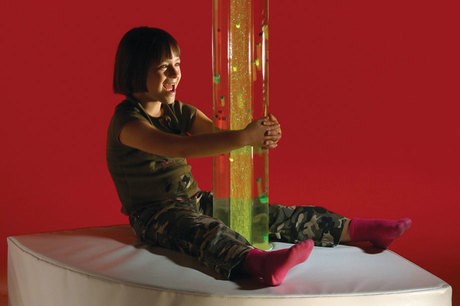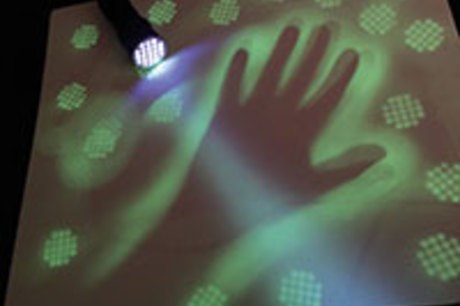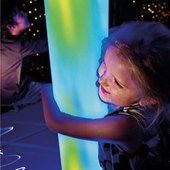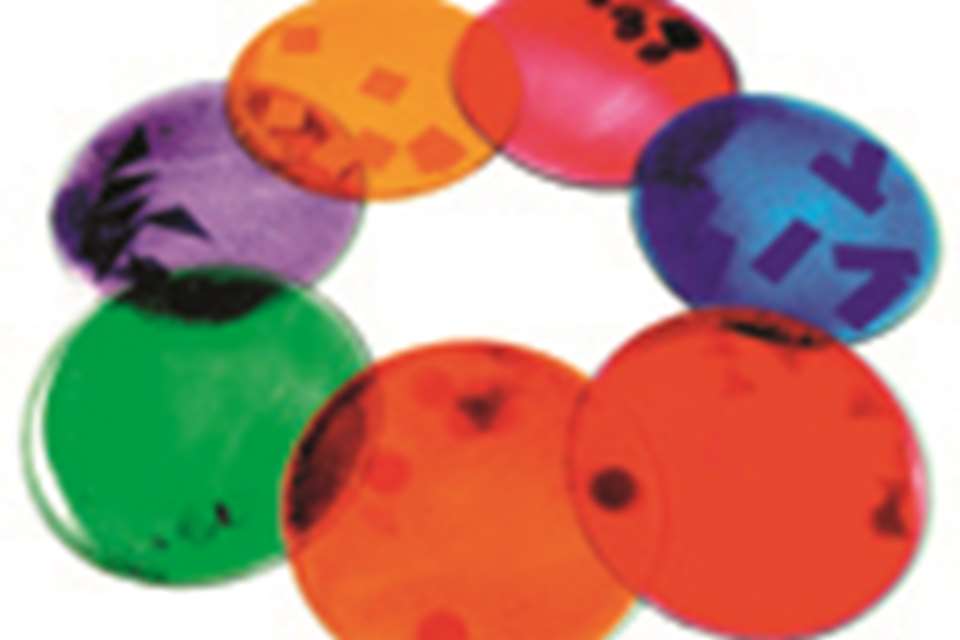Nursery Equipment: Sensory Spaces - Ready to relax
Nicole Weinstein
Monday, May 15, 2017
Calming sensory areas are transformational. Nicole Weinstein provides some tips for fitting them out

Flashing UV lights, bubble tubes with neon lights, fibre optic light sources… these are just some of the high-end sensory resources that are on offer for children with special needs. And while they may be the ideal solutions for specialist nurseries, they may, in fact, be the opposite of what is required for the majority of children in mainstream settings.
‘Generally speaking, specialist equipment that is expensive to install and static – lasers or UV lighting, for example – is your last option,’ explains Dr Kay Mathieson. ‘There are some children with extreme special needs where you do want a stimulating experience, but not many settings would have children with that level of need.’
Instead, settings should think about offering calming sensory experiences that counteract the over-stimulating environment that we live in. Dr Mathieson says, ‘Anxiety in children seems to be on the rise and sensory sensitivity can be a factor – TV, lighting, noise and music are constantly bombarding their senses. A sensory room is an ideal space to complement what they are getting elsewhere.’
HOW TO USE A SENSORY ROOM
First, not every setting has enough space for a dedicated sensory room. Play tents where children can explore light and dark are a cost-effective option. Another solution is to section off a corner of a room with drapes or use an outdoor space with a pop-up tent or camouflage nets and perhaps start by planting herbs so that children can smell the aromas of the lavender and mint, for example.
Whatever the solution, it is important to have boundaries around the space because there is something about being contained that can help children relax and surrender to their senses.
Effective use of sensory rooms and spaces can calm anxious children in order for them to better access the learning on offer. However, a dedicated sensory room could have multiple uses, including being an exciting place to tell stories or hold creative staff meetings.
 According to Dr Mathieson, all too often sensory rooms are used as places to put ‘over-excited, agitated children’ for time out, expecting them to calm down. She explains, ‘It should be used as a more preventative measure to help children before they get into that state. It’s a subtle difference, but it is key.’
According to Dr Mathieson, all too often sensory rooms are used as places to put ‘over-excited, agitated children’ for time out, expecting them to calm down. She explains, ‘It should be used as a more preventative measure to help children before they get into that state. It’s a subtle difference, but it is key.’
Shy and passive children often miss out on the sensory offering and it’s important to include these children and let them have some control over what takes place in the room. ‘Ensure that they have control over the music or the lighting. Let them invite someone into the space to share their experience,’ she says.
KEY POINTS TO CONSIDER
Try to think about creating an environment that is different from the rest of the setting.
Think about what particular children might be interested in – if it is light, provide different filters and coloured lights. Ensure that they can control the light and explore what the light does.
Don’t forget textures – carpet with knobbly bits, squidgy balls.
Seek local advice: visit special schools and talk to NHS staff, occupational therapists and speech and language therapists to get a sense of what resources are around and why you should use them. If you have a particular child with special needs, look through their care plan to see what other professionals are saying about this child’s sensory diet and what might be helpful and useful for them.
Think about flexibility of resources – if you know what you are looking for and you know how to use it, think outside the box. There are a lot of effective resources on the market that are not specialist equipment.
CASE STUDY: MORELAND CHILDREN’S CENTRE AND PRIMARY SCHOOL
Children at Moreland Children’s Centre and Primary School in Islington, north London, have had the benefit of a dedicated sensory room with fixed, specialist equipment, as well as a temporary sensory room sourced on a budget.
Catherine Lawrence, assistant head of nought to fives and SENCO across the school, says, ‘Before moving into our newly built children’s centre and school premises last November, we set up a temporary sensory room with a £1,000 grant from a local law firm. Prior to that we had a fully equipped sensory room that has now been moved into our new 3 × 2 metre room, and we have amalgamated all the resources.
‘The room is white with no windows. It’s equipped with bubble tubes that change colour when the children press the buttons, a UV ceiling light, an LED projector which comes with disks and projects patterns onto the wall, fibre optic tubes that glow and the children can pick up and hold, an interactive tunnel mirror which has a control panel to change the colours, and a shadow wall where children can make a print with their hand or using UV torches.
‘We have a lot of children with SEN across the school and the room is timetabled for children with autism on a daily basis. Children with some sensory difficulties find it easier to focus after time spent in the room – for example, such as those who might need movement prior to sitting down and learning.
‘For others, who are over-sensitive to noise, it can be a quiet space that dampens down sensations. We also use it for sensory stories where we take nursery groups in and create under-the-sea stories with the bubble tube and the projector.
‘When we were between premises, I created a sensory room with an entire budget of £1,000. I thought about how different resources could appeal to the senses and I sourced many items through Amazon or pound shops and some educational suppliers [see the examples below].’
SENSORY ROOM ON A BUDGET
Light and vision
Torches with different types of fabric – shiny; net – to shine the light through
Fairy lights
Mini Black Light, £3.99, www.cosydirect.com
Pico Genie P100 LED projector, which connects to an iPad and can be used with sensory apps, £249.99, www.picogenie.com
White Projector Tent, £14.99, www.cheapdisabilityaids.co.uk
White umbrella – great for projecting images onto in small spaces
Sensory Dark Den, £61.95, www.tts-group.co.uk
Large Glitter Ball, £3.50, www.playtoz.co.uk
Sensory Ball Pound Shop Pack, £22.49, www.cosydirect.com
Underwater Light Starship, £34.95, www.amazon.co.uk
Black umbrella with fairy lights stuck around the edges
A Space Light that projects star images, £5.99, www.cheapdisabilityaids.co.uk
Black-out blind to use as a projector screen
Movement
Sit On Gym Balance Ball, £18.99, www.tts-group.co.uk
Folding Trampoline, £59.95, www.tts-group.co.uk
Space hoppers
Tactile
Wooden massagers
Different textured balls from Ikea
Professional Bubble Machine, £37.99, www.cosydirect.com
Therapy Putty, set of four, £14.99, www.amazon.co.uk
Sheepskin rugs, bobbly bath mats from Ikea
Cushions in fake fur and with different textures
Aromatherapy diffuser and oils
CD player and relaxation CDs
Artificial flowers
Mirror tiles from Ikea
Training
Sensory training with Richard Hirstwood, www.hirstwood.com
 LARGE-SCALE EQUIPMENT
LARGE-SCALE EQUIPMENT
Interactive Bubble Tube with Wireless Switch Box, £775; Fibre Optic UV Sparkleflex & Lightsource, £310; Star Buy Projector Package, from £475 – all from www.spacekraft.co.uk
Write in Light – Shadow Board, £39.95, available from www.hirstwood.com






